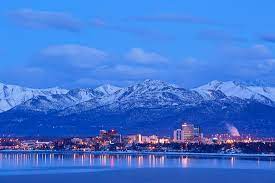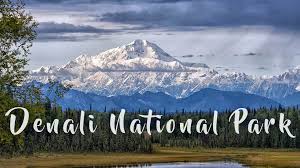ALASKA – 2 (1991) - Main Land
- Usha Shah
- Dec 26, 1991
- 5 min read
Anchorage, and onwards to Denali Park and Fairbanks.

From Juneau we flew to Anchorage, and onwards to Denali Park and Fairbanks.
Anchorage
In Anchorage we stayed at a Bed & Breakfast belonging to a lady. She stayed next door and when we reached there she was just stepping out for a meeting. She told us that the key with our room number is hanging there. The manageress lady will come a little later. Make yourself comfortable.And breakfast is laid out so help your self. As we got settled a little later on a father and son arrived who seemed to be regulars here. They had perhaps come for a day’s fishing trip.
When manageress came with her help we planned our sight seeing in Anchorage.
First we went to Earthquake Park in Anchorage. This is a park that commemorates the 1964 earthquake that caused a neighbourhood to slide into the ocean. The park features evidence of the earthquake, including rippling hills and a sharp drop-off. There are signs explaining the circumstances of the quake and its effect on the area. In the evening we went to a night market. Lots of festivities were going on and we walked around.
By now we had become friends with the staff. On her off day she offered to drive us to magnificent Portage glacier.
Portage Glacier is located in Chugach National Forest on the Kenai Peninsula. This is one of Alaska’s most accessible glaciers and most popular attraction. To reach there we drove on Seward Highway along the 5-mile Portage Glacier Road. And finally arrived at the impressive Begich, Boggs Visitor Center.
Portage Glacier is the crown jewel in a valley studded with alpine glaciers. The Portage Valley was literally shaped by glaciers and today is a perfect spot for exploring. Ten stories tall and miles long, Portage Glacier sits at the far end of a lake. Most visitors to the area start their exploration at the Begich, Boggs Visitor Center, built on the shores of Portage Lake on the glacier’s terminal moraine. This impressive visitor center features exhibits on the area’s wildlife, ecosystem, and the 1964 earthquake, and shows a nature documentary throughout the day in a large theater. Small ice chunks that have calved off of the glacier are routinely hauled out of the water and brought into the visitor center so visitors can see and touch the dense ice.
Our visit to magnificent Portage glacier was very interesting. When we reached first we were seated in an auditorium and saw a film. When the film ended they opened up the curtain – Lo and Behold we saw the real glacier through the glass. After the show we walked closer to the glacier along a path.
The Trail of Blue Ice is a 5-mile trail of wide gravel paths and boardwalks connecting many of the nearby glaciers and campgrounds for hikers and bikers. It’s also a great trail for salmon viewing.
The nearby Byron Glacier Trail travels less than a mile from the trailhead to toe of the glacier, and Forest Service rangers from the visitor center lead a popular hike during summer. We walked along this shorter trail after the film show.
This wonderful trip ended with dinner hosted by our friends at an Italian restaurant.
Denali National Park
From Anchorage we went on to “ Denali National Park “ by train. An interesting experience was that we didn't have our train tickets with us. The travel agent had told me that the tickets for our train travel couldn’t reach her before we leave. So she suggested that we should collect tickets at the station on reaching there. They will be placed in an open wooden box at the train station. And they were sitting there just as she told.
We were also lucky in our booking for our stay in Denali Park. As she was looking for our stay, she exclaimed - You are lucky, you get two for one. She told that by paying for only one night we can stay for 2 nights.This allowed us two nights stay and two bus trips.
This park was created in 1917; at the time, the purpose was to protect Dall sheep from over-hunting. The park's size and purpose grew over time. The park is now around 6 million acres, and much of the park must remain devoid of human development. Denali National Park and Preserve, formerly known as Mount McKinley National Park, is a United States national park and preserve located in Interior Alaska .
Denali is six million acres of wild land, bisected by one ribbon of road. As you drive along the road we see the relatively low-elevation taiga forest give way to high alpine tundra and snowy mountains, culminating in North America's tallest peak, 20,310' Mt.Denali. Denali is home to many wild animals.
Wild animals large and small roam un-fenced lands, living as they have for ages. All around is Solitude, tranquility and wilderness.
North America's tallest peak, 20,310' Mt.Denali / Mt. McKinley - In 1896, a gold prospector named it McKinley as political support for then-presidential candidate William McKinley, who became president the following year. The United States formally recognized the name Mount McKinley after President Wilson signed the Mount McKinley National Park Act of February 26, 1917.
Denali, officially known as Mount McKinley, is the highest mountain peak in North America, with a summit elevation of 20,310 feet above sea level.
On both the days Mt. McKinley was at its best.
Denali is the third most prominent and third-most isolated peak on Earth, after Mount Everest, Mount Kilimanjaro and Mount Fuji.
During our outings we saw some wild life, including a black bear that are considered to be very shy.
Fairbanks
In Fairbanks, we again stayed at a home stay. The hostess guided us about what to do in Fair Banks. She showed some photographs of Northern lights taken by them. She also showed small pieces of gold that one finds in rivers on panning.
We went to a museum in university, and we were surprised to meet a few Indian students who were studying Oil Technology courses.
Another outing was an evening show of Aurelia Borealis in simple terms Northern lights on a multiple screen out in the open under the sky. This was located on the outskirts of the town.

Another popular spot is to see the Trans-Alaska Pipeline at the viewpoint 15 minutes north of Fairbanks.

The Trans-Alaska Pipeline traverses 800 miles (1,287 kilometers) through the Alaska wilderness from the oil fields of Prudhoe Bay on Alaska’s North Slope, south to Valdez on the shores of Prince William Sound where it is shipped to refineries. Built between 1974 and 1977 and requiring over 28,000 people to build, the pipeline is considered one of the world’s most amazing









Commentaires